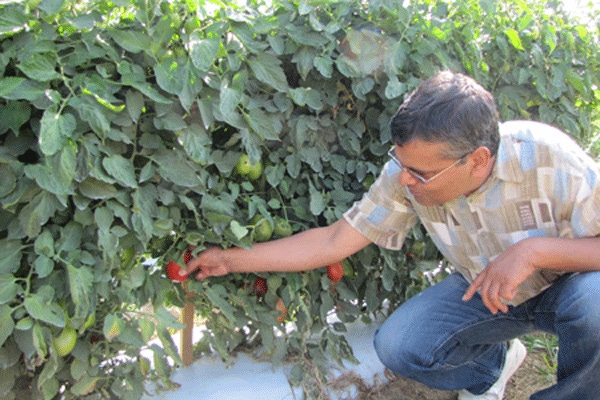April 2, 2013

Using a combination of new tools and time-honored techniques, Dilip Panthee is carrying on North Carolina State University’s strong tradition in plant breeding, developing hardier, higher-yielding plants for North Carolina’s $30-million-a-year tomato industry.
North Carolina State’s College of Agriculture and Life Sciences has the nation’s largest university plant breeding program. Panthee, an assistant professor of horticultural science, proudly follows in the footsteps of Randy Gardner, a retired breeder credited with developing the cultivars used on some 60 to 75 percent of the vine-ripe tomatoes grown in the eastern United States.
When Panthee joined the faculty nearly five years ago, he brought skills in molecular marker-assisted breeding that he honed as a doctoral student and post-doctoral researcher at the University of Tennessee. And he came with a passion for and understanding of tomatoes that he gained during his early career as a breeder in Nepal, his home country.
Working at the Mountain Horticultural Crops Research and Extension Center in Mills River, Panthee focuses his efforts on developing tomato breeding lines and cultivars with three traits: disease resistance, fruit quality and stress tolerance. That’s because, in a survey the scientist conducted at the start of his tenure at North Carolina State, these three traits were the ones North Carolina growers reported needing the most.
To help address industry problems, Panthee takes a multi-faceted approach — part conventional breeding, part molecular marker-assisted selection (MAS). MAS isn’t genetic engineering; it’s simply a breeding short-cut that’s especially helpful when it comes to developing disease-resistant varieties using DNA-based markers.
In conventional breeding methods, scientists would inoculate plants with a disease to see which ones are resistant, but that runs the risk of spreading the disease, Panthee explains. However, with MAS, scientists can look for what are called markers — sequences of nucleotides that make up a segment of DNA — that are near the genes of interest in the genome.
To develop a tomato resistant to tomato mosaic virus, for example, Panthee has identified the molecular marker that is tightly linked with the TMV resistance gene, so as he breeds successive generations of plants, he selects only plants that contain that marker.
Can enhance generations quickly
“I keep on selecting plants that contain the TMV resistance genes and discard the plants that do not have TMV resistance,” he explains. “That way I can enhance these generations quickly.”
Panthee expects to begin releasing disease-resistant cultivars born of these methods within the next two or three years.
Already, in collaboration with Gardner, Panthee has helped develop Mountain Merit, a high-yielding, fresh-market cultivar with resistance to late blight, tomato spotted wilt virus and root-knot nematodes, and Mountain Majesty, a large-fruited tomato with improved fruit color and resistance to tomato spotted wilt virus.
Working with his Mills River colleague Jeanine Davis, Panthee also has developed heirloom tomato hybrids that are taste-test winners and would work well for organic farmers. And with Penny Perkins-Veazie of the college’s Plants for Human Health Institute in Kannapolis, Panthee is looking at ways to produce tomatoes with high levels of lycopene, a health-enhancing antioxidant. They are getting close, he says, to releasing a grape hybrid line with just such qualities.
While Panthee’s work focuses on tomatoes bred especially for North Carolina’s growing conditions, he’s also advancing the science of plant breeding as well as our understanding of molecular-level plant-pathogen interactions.
With scientists from Cornell University, he is collaborating on a $4 million National Science Foundation-funded research project designed to shed light on the protein-based war that takes place when pathogens infect a plant. The study focuses on what happens when susceptible and resistant varieties are exposed to Pseudomonas syringae, which causes bacterial speck.
“We want to see what types of proteins are transcribed and how they are expressed and how they behave in resistant and susceptible lines,” Panthee says. “And the approach we are using can be used to explore interactions between other pathogens and other plants ��– for example, rice or pepper or corn.”
Making sure that such research has practical significance for North Carolina growers is, in the end, what Panthee’s breeding program is all about.
“The best approach,” he says, “is to develop high-yielding varieties while minimizing post-harvest losses. That increases the amount of marketable fruit, which means the cost of production for our tomato growers will be less. And that means they can be competitive.”
Want access to the very latest in agriculture news each day? Subscribe to Southeast Farm Press Daily.
You might also like:
Farm profitability outlook updated after USDA reports
Auburn releases first peanut variety; others on the horizon
Stocks report sends corn futures tumbling
Industry news: Brent introduces 96-series Avalanche grain carts
You May Also Like




